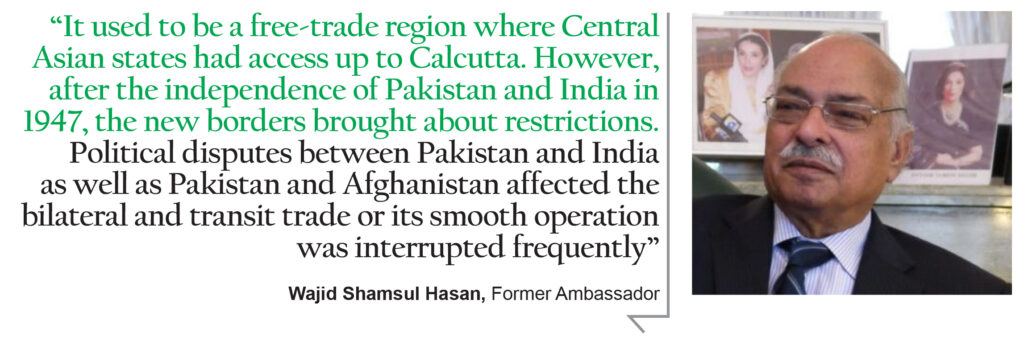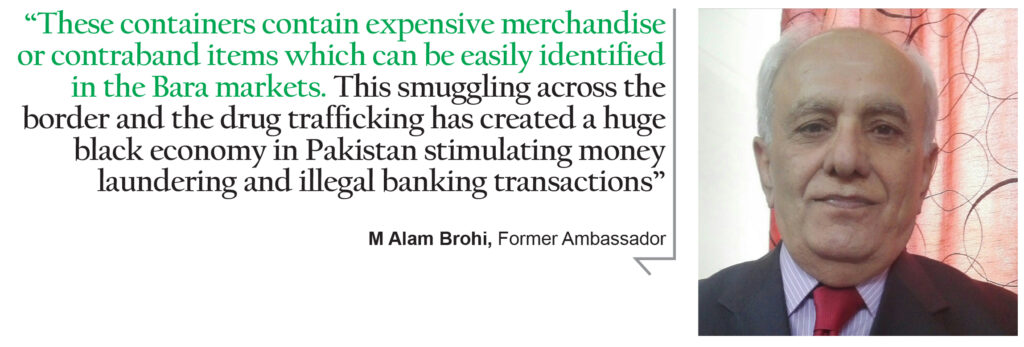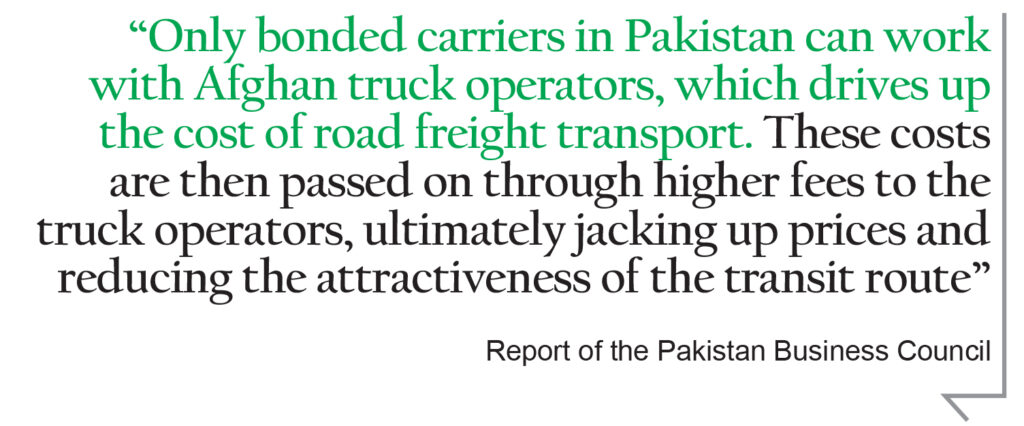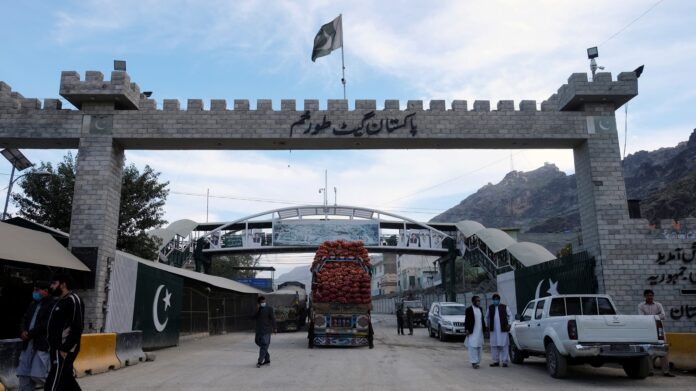Former Afghan President Hamid Karzai once dubbed Pakistan and Afghanistan siamese twins. The epithet about the two neighbouring states that share a nearly 2,500-kilometer long border, the Durand line, established in 1893 by the British colonial government, was poignant.
While the Durand line has served as an official border between the two states since the 19th century, it has for long remained a porous border. Pashtun tribes on either side of the line have close family ties with each other, and their common cultural practices, shared heritage, and national identity. After the partition of the Indian subcontinent, the Durrand line remained a contentious border for decades, with calls for the then North Western Frontier Province making up an independent state and the legality of the border challenged in international courts.
It would not be until 1976, when on a visit to Islamabad, the Afghan President, Sardar Mohammad Daoud Khan, would officially recognise the Durand line as the official border between Pakistan and Afghanistan. In all these years, despite people crossing regularly, the border remained a hot area. After the recognition of the Durand line, however, it was hoped that Pakistan and Afghanistan could engage in greater trade ties.
This was particularly important for Afghanistan, which, as a landlocked country, needed routes to the sea for trade. While the United Nations Convention on the Law of the Sea (UNCOLS) of 1982 provides the right to access to and from the seas for land-locked states, these rights are subject to bilateral agreements to be made between land-locked and transit states.
However, a two-way transit agreement would not be signed between Pakistan and Afghanistan until as late as 2010. The Afghanistan Pakistan Transit Trade Agreement (APTTP) allowed reciprocal transit rights to both Pakistan and Afghanistan. As per UNCOLS, the two states bilaterally decided that access to the sea was less important than allowing land routes to and from India and Central Asia.
The treaty has had its moments, but it has also been plagued by the constant bickering between the Afghan and Pakistani governments. Hostile statements and actions by different state and non-state elements in both countries have meant the border being closed and reopened at different times, leaving many skeptical of whether the treaty has anything left in it.

Recently, the Pakistan Business Council (PBC) has come forward to say that it wants a framework for renegotiating the Afghanistan Pakistan Transit Trade Agreement. The suggestions they have made are ambitious, but can they ever be implemented? And more importantly, will regional politics ever allow Afghanistan and Pakistan to trade effectively?
A brief history
The 2010 agreement was not the first transit treaty that the two countries have signe. Back in 1965, both Pakistan and Afghanistan signed the Afghanistan Transit Trade Agreement (ATTA), which provided transit to Afghanistan via Pakistan. However, it did not provide transit to Pakistan via Afghanistan to the then Soviet Union. The 2010 treaty was then signed in the interest of allowing Pakistan reciprocal transit rights, which meant routes through Afghanistan to Central Asia. An MOU was signed, allowing a formal transit agreement – The Afghanistan Pakistan Transit Trade Agreement (APTTA) to come into existence.
Under the newly signed APTTA, Afghan trucks can enter Pakistan via border crossings at Torkham, Ghulam Khan, and Chaman to transport their goods across Pakistani territory, and to import goods from Pakistani ports in Karachi, Port Qasim, and Gwadar. The signed agreement also permits Afghanistan trucks access to the Wagah border with India, where Afghan goods are offloaded onto Indian trucks. However, the treaty does not permit Indian goods to be loaded onto trucks for transit back to Afghanistan.
On the other hand Pakistan gets access to every country bordering Afghanistan, with access to Iran via the Islam Qila and Zaranj borders, Uzbekistan via the Hairatan border, Tajikistan via Ali Khanum and Sher Khan Bandar crossings, and Turkmenistan via the Aqina and Torghundi border crossings. Pakistani imports and exports are granted permission to enter Afghanistan via border crossings at Torkham, Ghulam Khan, and Chaman.
The agreement also calls for various measures to counter smuggling of duty-free goods into both Pakistan and Afghanistan by mandating: tracking devices of goods, financial guarantees and special bonded carrier licenses for transit trucks, vehicular tracking systems, and container security deposits.
This is monitored by the Afghanistan-Pakistan Transit Trade Coordination Authority (APTTCA), which was created to coordinate the Afghanistan–Pakistan Transit Trade Agreement and meetings are held.
The treaty is good on paper. However, it has not been so fruitful on the roads. Constant tensions between the government of President Hamid Karzai and Pakistan meant that much of the APTTA provisions remained unexploited since 2010.
The earlier mentioned PBC has recently released a report that details the problems with the agreement, and why a restructuring is desperately needed. This is particularly true since back in October 2017, responding to Pakistan not allowing Afghan trucks to enter its territory, incumbent Afghan President Ashraf Ghani had announced that the agreement has expired and Pakistai trucks would have to offload at the border crossing at the Durand line from now on.
The report explains how Afghanistan has complained that the anti-smuggling security measures agreed in the APTTA are restrictive, cost prohibitive, and that banking and insurance guarantee fees are excessively high and time consuming, ranging from Rs. 100,000 to Rs.150,000 per carrier. Banks from both countries have also refused to offer such guarantees, further delaying customs clearances.
The required truck-tracking systems have been implemented in Pakistan, while the Afghan side has yet to install such systems on their own trucks. Afghanistan also refuses to grant Pakistan the right to import and export goods from Central Asia across Afghan territory. The 2010 APTTA agreement allowed for Afghan goods to be exported to India via Pakistani territory, but did not permit Indian goods to in turn to be exported to Afghanistan across Pakistani territory.
The PBC’s report has listed a number of issues as significant in why the situation is so grim and inefficient. For starters there are the Torkhan And Chaman border-crossing points (BCPs). These are the two points where Pakistani trucks enter Afghanistan, and they are also the most time-consuming nodes, with lines sometimes stretching for miles.
Then there is the fact that only bonded carriers in Pakistan can work with Afghan truck operators, which drives up the cost of road freight transport as the bonded carriers are required to pay $32,000 to the Federal Board of Revenue as a guarantee deposit to receive an operating license. These costs are then passed on through higher fees to the truck operators, ultimately jacking up prices and reducing the attractiveness of the transit route.
The report further stated that the CPMM trade facilitation indicator (TFIs) reported longer average border-crossing time, although relatively unchanged average border-crossing cost. Essentially, this means that measures of speeds showed that trucks did not move as fast as they did in 2018. In fact, the average border-crossing time increased to 38.2 hours. The time to cross Chaman was 60.1 hours, ranked as the most time-consuming BCP in 2019, Peshawar took 45.8 hours, and ranked the third most time-consuming.

Average border-crossing costs remained comparatively unchanged. Peshawar averaged $319 to complete border crossing in 2019, while Chaman was lower at $156. Greater adoption of freight on rail and inland waterways would reduce freight costs and boost low- unit value exports such as agricultural produce.
There is, in all this, also the CPEC factor that has caused tensions between Pakistan and Afghanistan in recent years. One of the challenges for Pakistan is that they need off-season access for five months of the year when the roads are closed.
Pakistani trucks in China enroute to central Asia were frustrated by Afghanistan’s refusal to allow Pakistani goods access to Central Asian markets until Indian exports are granted reciprocal access to Afghan markets. Owing to this frustration, and the ongoing construction of roadway projects to China under the China-Pakistan Economic Corridor, the Pakistani Government in February 2016 signaled its intention to completely bypass Afghanistan in its quest to access Central Asia by announcing its intent to revive the Quadrilateral Traffic in Transit Agreement. This allows the Central Asian republics to access Pakistan’s deep water ports without having to rely on a politically unstable Afghanistan as a transit corridor.
However, the QTTA would not allow Pakistan access to Turkmenistan and Iran across Afghan territory as the APTTA does. In early March 2016, the Afghan government reportedly acquiesced to Pakistani requests to use Afghanistan as a corridor to Tajikistan, after having dropped demands for reciprocal access to India via Pakistan. The Kasghar route however is seasonal and open for 7 months of the year only.
Political dimension of Afghan-Pak ties
As a land-locked country with a storied and embattled history with Pakistan, the thing that has consistently held back different transit trade agreements and cooperation in general has been the political tensions between the two states.
Speaking to Profit, former ambassador M Alam Brohi, who is an expert on Pak-Afghan ties and served for three decades in foreign services of Pakistan, says that from 1947 to 1980, Pakistan never tried to create hurdles in the foreign trade of Afghanistan or withhold any of the facilities as provided in the bilateral agreements between the two countries.
The consignments for Afghanistan continued arriving at the Karachi seaport and transported by road and railway to Peshawar and onwards to Kabul without any hitch or delay as the imports included consumer goods and provisions. Pakistan also had an ever-flourishing border trade with Afghanistan passing through Peshawar and Chaman.
Thousands of trucks loaded with merchandise to and from Afghanistan pass through these two-border check posts every week. In addition, lots of trucks carrying grains of staple foods including wheat, rice and flour pass the not-so-secure or unmanned points of the border with the connivance of the border policing agencies. Another unpleasant aspect of the transit trade is that a substantial number of containers just formally cross the Afghan border and clandestinely return to Pakistan from unmanned points.
“These containers contain expensive merchandise or contraband items which can be easily identified in the Bara markets. This smuggling across the border and the drug trafficking has created a huge black economy in Pakistan stimulating money laundering and illegal banking transactions,” says Ambassador Brohi.

Any meaningful check on these illegal trade transactions irritate Afghan traders as well as the government. Their hostility to Pakistan on this count has been more pronounced during the successive civilian governments installed in Kabul as a result of the US-sponsored Bonn process. These regimes included the interim term and two terms of Hamid Karzai, and Ashraf Ghani’s one term in the Afghan Presidency. Notwithstanding hiccups in the bilateral relations, the bilateral trade between two countries had peaked at US dollars 2.5 billion in the mid 2000s. Pakistani merchandise accessed Central Asian markets too through Afghanistan.
The Ambassador maintains that these Afghan regimes linked their road transit facility to Pakistan for access to the Central Asian markets with India’s access to Afghanistan through Wagah Border. “This created an anomaly for Pakistan. India was brazenly engaged in destabilizing Pakistan from the eastern border and aiding and abetting insurgency in Balochistan using the Afghan land in collusion with the Afghan intelligence,” he says. “The Afghan leaders have been denying access to Pakistan for Central Asia for the last many years.” He goes on to argue that Pakistan kept opening the routes and roads for the Afghan transit trade and helped in rebuilding of the war ravaged Afghanistan despite all this.
However, the heavy leanings of Afghanistan to India adversely impacted bilateral trade between the two countries, which reduced to $1.5 billion by 2017-2018. This was unfortunate. The years 2016-2017 witnessed a steep decrease in the mutual trust and confidence between the two countries.
Ambassador Brohi believes that the Afghan President Ashraf Ghani was hand in glove with India in humiliating Pakistan in conferences on Afghanistan. Later, he joined hands with India and Iran to inaugurate projects for trilateral cooperation in transit trade from the Chabahar Seaport just 70 kilometers across Gwadar Deep Seaport.
“If the participation of Afghanistan in the trilateral transit trade facility was to reduce its chronic dependence on Pakistan, it was a justifiable move. But the trilateral collusion had much more than what meets the eye. The move was aimed to strike a blow to the CPEC, though Iran and Afghanistan had an open invitation to join it,” Ambassador Brohi says.
Though the US had not embargoed the Iranian oil exports, India dilly dallied in its oil imports from Iran. Similarly, India also lost interest in making additional investments as pledged in the Chabahar Seaport and the road and railway projects connected with the transit trade. China, in a diplomatic coup, signed long term agreements with Iran for investment of some $400 billion over a period of 25 years in Chabahar and the road and railway projects and taking bulk of the Iranian oil. India just displayed more interest in strengthening its relations with the US than standing by Iran in its most difficult hour.
“Pakistan has always been interested in peace and stability in Afghanistan. It has been stressing the need for a negotiated resolution to the Afghanistan imbroglio. The USA, in its arrogance of a superpower, was not ready to listen to our sane and wise counsel. It wanted to win the war by their lethal military power. When President Donald Trump’s policy of ‘maximum pressure’ did not yield dividends, they grudgingly veered to the proposition of dialogue with their bête noire, Taliban.”
Afghanistan’s internal affairs
Within Afghanistan, there are warlords who have politically and financially benefited from the current unstable conditions. Afghanistan has become a narcotic country. The drug trade has skyrocketed to over $25 billion, enriching drug traffickers, warlords, drug control agencies and power wielding elites. Afghan society is fragmented by extreme religious and political affiliations and unbridgeable sectarian, ethnic and linguistic divide. All these contradictions will impact the intra Afghan talks.
Ambassador Brohi says there are states including Pakistan, Iran, Turkey, China, Russia and India which have apparently developed cross purpose objectives during the war in Afghanistan. “While Pakistan would like to see the Taliban sharing power with the present Afghan leadership, India is publicly opposed to the Taliban and the process of dialogue. With its influence on the present Afghan leaders, particularly with those from the Northern region, India is certain to play the main spoiler’s role. Iran would not overlook the persisting sectarian divide in the country and the escalating tension in the Gulf region.
China is interested in peace in Afghanistan because of its concerns about the growing unrest in it western Xinjiang region. Russian leaders would like to see the USA exiting from the region which, they believe, has been stoking extremism in the Central Asian region.
On the other hand, Ambassador Wajid Shamsul Hasan who writes frequently on Pak-Afghan ties, says Pakistan and Afghanistan have been traditional trading partners for centuries. “It used to be a free-trade region where Central Asian states had access up to Calcutta. However, after the independence of Pakistan and India in 1947, the new borders brought about restrictions,” he explains. “Political disputes between Pakistan and India as well as Pakistan and Afghanistan affected the bilateral and transit trade or its smooth operation was interrupted frequently.”
Despite bitterness in relations, bilateral trade has continued unabated between Pakistan and Afghanistan. After 9/11, the trade volume increased from $25 million of $ 2.5 billion in 2010. However, with the passage of time and emerging tensions between the two countries and Iran’s aggressive transit trade facilitation the bilateral trade between Pakistan and Afghanistan has come down to less than a billion dollar.
“A number of factors need to be looked at in relation to the Afghanistan-Pakistan Transit Trade Agreement (APTTA), says Ambassador Hassan. “The agreement was signed in 2010 with the facilitation of the US. APTTA replaced Afghanistan Transit Trade Agreement (ATTA) of 1965, primarily because the latter was one-sided transit trade facilitation to Afghanistan while Pakistan had no access to the Central Asian states of the former Soviet Union. APTTA provides access to Pakistan to the Central Asian states.
While institutional mechanisms are in place between Pakistan and Afghanistan, systemic inefficiencies such as corruption, technological barriers (trackers, scanners) and infrastructure problems have badly affected the transit trade between the two countries.”
He also says that one point of contention is Afghanistan’s insistence on uninterrupted access to India, which Pakistan sees as a threat to its national security. “Although Afghan trucks can reach up to Wagah, Indian trucks cannot go into the Afghan territory via Pakistan due to lack of an agreement between Pakistan and India. Secondly, India has never raised the transit trade issue with Pakistan. Third, unless India gives access to Pakistan to use Indian territory to reach out to Nepal and Bhutan, Pakistan is not obliged to facilitate India.”





People make the system sound so complicated. Create win-win deal for all by facilitating trade, rather than being an obstruction. Allow India to trade with Afghanistan and the central Asian republics through Pakistan, through this system Pakistani state and the Pakistani people prosper as well. Create dry ports at the border with India and only allow Pakistani transport enterprises be it rail or trucks etc. to pick up the Indian goods in Pakistani territory. Also put a small duty for trade facilitation say 2.5%-5% or something small like that which will not raise the cost of goods too much for Indian goods going through Pakistan. We benefit the most in this scenario. By allowing Indian exports to Afghanistan through our territory, we can also gain access to the Central Asian countries and vice versa. Allow the landlocked Central Asian countries access to the Gawadar port and see trade grow overall in the region.
The issue is that those Indian goods destined for Afghanistan will be smuggled right back into Pakistan. India-Afghanistan trade will skyrocket on paper, but those goods will actually be seeking back into Pakistan without paying taxes and duties to Pakistan. Afghanistan will gain duty revenues for Indian goods being sold in Pakistan. This is inevitable until the border with Afghanistan is fully sealed, but the Afghans object to that.
Few things:
1) trade was higher with Afghanistan in the early 2010s because the large number of foreign forces there and investment in security infrastructure that relied on Pakistani cement and furnishing. That market is gone. Secondly, trade decreased later not just because of that, but also because sanctions against Iran were reduced and trade evened out towards Iran (not India).
2) Afghanistan was never historically the destination of caravans from South Asia. Afghanistan was just a wild frontier on the way to the real treasures of the era: Bukhara and Samarkand. Afghanistan never was a lucrative market, it’s biggest exports were dried fruit.